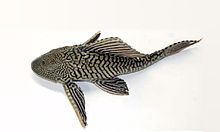
Catfish are a diverse group of ray-finned fish. Named for their prominent barbels, which resemble a cat's whiskers, catfish range in size and behavior from the three largest species alive, the Mekong giant catfish from Southeast Asia, the wels catfish of Eurasia, and the piraíba of South America, to detritivores, and even to a tiny parasitic species commonly called the candiru, Vandellia cirrhosa. Neither the armour-plated types nor the naked types have scales. Despite their name, not all catfish have prominent barbels or "whiskers". Members of the Siluriformes order are defined by features of the skull and swimbladder. Catfish are of considerable commercial importance; many of the larger species are farmed or fished for food. Many of the smaller species, particularly the genus Corydoras, are important in the aquarium hobby. Many catfish are nocturnal, but others are crepuscular or diurnal.

Callichthyidae is a family of catfishes, called armored catfishes due to the two rows of bony plates along the lengths of their bodies. It contains some of the most popular freshwater aquarium fish, such as many species in the genus Corydoras.

Loricariidae is the largest family of catfish, with over 90 genera and just over 680 species. Loricariids originate from freshwater habitats of Costa Rica, Panama, and tropical and subtropical South America. These fish are noted for the bony plates covering their bodies and their suckermouths. Several genera are sold as "plecos", notably the suckermouth catfish, Hypostomus plecostomus, and are popular as aquarium fish.

Hypostomus is a genus of catfish in the family Loricariidae. They are native to tropical and subtropical South America. H. plecostomus is the popular freshwater aquarium fish formerly known as Plecostomus plecostomus. The taxonomic structure of the Loricariidae is still being expanded by scientists. Hypostomus is a highly species-rich and widely distributed catfish genus.

The genus Panaque contains a small number of small to medium-sized South American suckermouth armoured catfishes that are notable for being among the very few vertebrates that feed extensively on wood. In addition, algae and aufwuchs are an important part of the diet, and they use their rasping teeth to scrape this from rocks. These fish are also popular aquarium fish, where the sound of scraping as these fish forage for food is easily audible.

The loach catfishes are a family, Amphiliidae, of catfishes. They are widespread in tropical Africa, but are most common in streams at high elevations; most species are able to cling to rocks in fast-flowing streams. The 13 genera contain 68 species.

Astroblepus is a genus of fish in the family Astroblepidae found in South America and Panama. This genus is the only member of its family. These catfishes are primarily found in torrential streams in the Andean area. Astroblepus pholeter and A. riberae are troglobites adapted to living in subterranean water systems. These species are typically small, less than 10 cm (4 in). The largest species reaches 30 cm (1 ft). These fish have suckermouths like those of loricariids. They have two pairs of barbels, maxillary and nasal. The dorsal fin spine lacks a locking mechanism. These fish also have odontodes, tiny teeth on their skin. All species exhibit a conical, pointy type on their fin rays like that found in other loricarioids; other species also exhibit a blunt type that is only found on their skin.
Scoloplax is the only genus in the catfish family Scoloplacidae, the spiny dwarf catfishes.

Peckoltia is a genus of small South American armored suckermouth catfishes. Many of these fish are popular aquarium fish.

Hemiancistrus is a genus of suckermouth armored catfishes. These species are native to South America. The taxonomy of this genus is complex and unclear, and major work has to be done. Many of these fish are popular aquarium fish.

The Hypoptopomatinae are a subfamily of catfishes of the family Loricariidae, composed of 17 genera and approximately 80 species. This subfamily represents about one-tenth of all loricariid species.

Sisoroidea is a superfamily of catfishes. It contains the four families Amblycipitidae, Akysidae, Sisoridae, and Erethistidae; many sources also include Aspredinidae. With Aspredinidae, this superfamily includes about 42 genera and 230 species.

Ancistrini is a tribe of catfishes of the family Loricariidae. Most are restricted to tropical and subtropical South America, but there are also several genus in southern Central America.

Hemiodontichthys is a monotypic genus in the family Loricariidae, under the order Siluriformes, containing a single species, Hemiodontichthys acipenserinus, also known as the Pinocchio whiptail catfish, Pinocchio catfish, Pinocchio cat or the knob-nosed whiptail. This shy, bottom-dwelling catfish is native to the Guianas, Brazil, Bolivia and Perú in South America.

Corydoras revelatus is an extinct species of callichthyid catfish known from a single specimen found in Late Paleocene strata of the Mais Gordo Formation in Salta, Argentina. According to chronological dating of the strata, the fossil specimen is about 58.2–58.5 million years old.
Scott Allen Schaefer is an American ichthyologist working at the American Museum of Natural History as the dean of science for collections, exhibitions, and the public understanding of science; he serves as the curator-in-charge, in the department of ichthyology, within the division of vertebrate zoology.
Corydoras isbrueckeri is a tropical freshwater fish belonging to the Corydoradinae sub-family of the family Callichthyidae. It originates in inland waters in South America. Corydoras isbrueckeri is found in Bolivia.
Scleromystax reisi is a species of catfish of the family Callichthyidae. Its distribution is in the streams of tributaries of the rio Jacuí and rio Camaquã of the laguna dos Patos drainage, of the Rio Grande do Sul in Brazil.

Scoloplax dicra is a species of spiny dwarf catfish found throughout the river basins of South America.
Afrocascudo is a controversial genus of extinct neopterygian fish, either an ancient loricariid catfish or a juvenile obaichthyid lepisosteiform of the genus Obaichthys. It is known from the Late Cretaceous Douira Formation of Morocco. The genus contains a single species, A. saharaensis, known from a partial articulated specimen.















